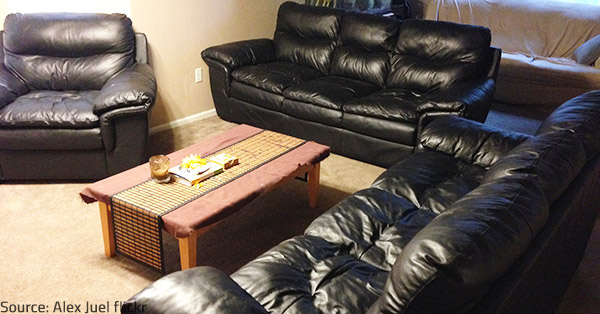
An elegant leather furniture set gives uniquely luxurious look and feel to your living room.
When envisaging your dream home, you probably picture a luxurious living room fitted out with expensive pieces of polished wood and patterned rugs alongside a full set of elegant leather furniture. Add some tasteful decorations and impressive light fixtures and you will have designed a genuinely charming artistic refuge in your home. However, this rich and delightful vibe would never be possible without the stunning beauty distinctive to leather. And while owning such deluxe furniture is usually assumed to be the privilege of wealthy people only, buying leather pieces is actually a good long-term investment for everyone. Unlike many other materials which fade and wear out easily, leather becomes even more beautiful over time since aging brings out its natural patina. Therefore, it can last really long when properly taken care of.
Actually, caring for leather furniture is not a difficult task at all. Provided that you protect it from the playful chewing and scratching your pets find so enjoyable, all you need to do is use an appropriate leather conditioner once or twice a year and you will be able to preserve the good look of your pieces without much effort. Just make sure you wipe up spills and remove stains as soon as they occur and avoid using regular cleaning agents as they can easily damage the delicate leather upholstery. However, to ensure your peace of mind, opt for furniture pieces that have an extra finish applied to the leather to provide better protection.
How to Care for Leather Furniture
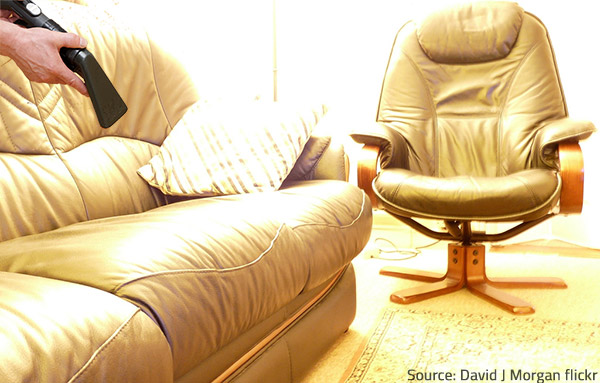
Delicacy requires gentle treatment – always use the soft brush attachment of your vacuum cleaner for leather furniture.
You can keep your leather furniture clean and beautiful for many years to come following some simple maintenance tips.
- Use a vacuum cleaner to remove any debris or excessive dirt from your leather furniture, paying special attention to the spaces between seat cushions. Remember to only vacuum on low speed and always use the soft brush attachment because the plastic cleaning attachments can easily scratch the leather;
- Dust your leather furniture regularly and wipe it all over with a dry clean cloth;
- Wipe with a soft slightly damp cloth if grime has built up at certain places. Use a white cloth to make sure no dye can accidentally permeate the leather and leave a stain;
- Apply an adequate leather conditioner every 6 months for best maintenance;
- Avoid direct sunlight and keep your pieces at least two feet away from any heat source in your home because the delicate leather can slightly fade or crack when exposed directly to strong light and heat;
- Protect your furniture from young kids and pets because they can accidentally damage it – provide an additional covering when you leave your little ones to play on it;
- Cover your leather pieces with plastic wrap, sheets, or any suitable cotton clothes if you are leaving the house or don’t intend to use the furniture for a longer period.
Leather Furniture Cleaning
Whenever your leather furniture needs some deeper cleaning be very careful – using harsh or abrasive cleaning agents and scrubbing hard may damage your pieces beyond repair. Get hold of adequate leather care products and be as gentle as possible. If your piece has a protective top coat, it is generally safe to clean it by yourself, using non-professional techniques. Here is a foolproof checklist for cleaning your leather furniture:
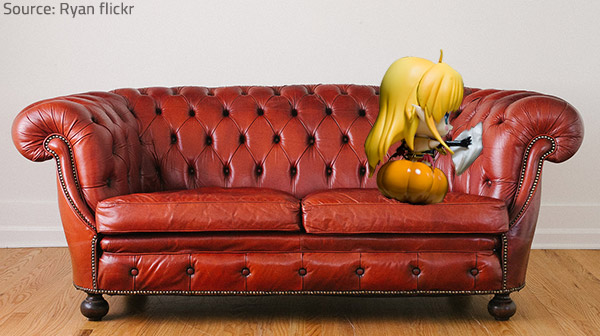
You probably don’t have a maid robot to clean your home, so you’d better learn how to wipe your leather furniture properly.
- First, check what specific type of leather you have and consult the information available for it. The tags attached to your piece when you purchased it and the documents that came with it usually contain basic care and maintenance tips, as well as cleaning instructions. The manufacturer will have recommended the most appropriate cleaning procedures for your particular furniture, so you are advised to follow them strictly for best results;
- Add a few drops of very mild natural liquid soap to a quart of lukewarm distilled water and stir well. Remember that harsh soap or strong detergents can strip the leather’s natural oil causing it to dry out and eventually crack;
- Test the solution on a small spot that is hidden from view;
- Dip a soft cloth in the soapy water and wring it out. If you soak the stained spot heavily with water, you will damage the leather;
- Gently wipe the soiled surface. If you rub harder, you will push the dirt deeper or you may even rub through the leather;
- Rinse the cloth repeatedly or use another one moistened with clear water to rinse the spot every now and then;
- Alternate with a clean dry cloth to wipe away the dirt and as much of the water as possible;
- After repeating the process several times, dry thoroughly using yet another dry cloth (again – don’t rub, just blot the moisture) and let air dry completely;
- If the results are satisfactory, apply leather conditioner to keep the leather supple and protected;
- Finally, buff the surface to restore luster.

Here is an idea on how to clean leather furniture quickly and efficiently.
However, if your leather furniture was heavily soiled, the above-described method may not be enough. In this case you need to purchase a specially designed leather cleaning product, preferably one that contains natural beeswax. It will not only clean but also nourish the leather and will not soak too much into it, allowing it to breathe. Nevertheless, spot-test the product on an inconspicuous area of your furniture first, because it contains solvents they may cause discoloration (if this is the case, try another cleaner, specifically recommended for your type of leather furniture). Squirt only a little of the product on a soft cloth and rub with gentle circular motions. Remember to always begin from the cleaner areas towards the dirtier ones and replace the cloth with a clean one often. Rinse the washed surface with a rag dampened in clean water repeatedly and blot dry. If your leather is as clean as new, just apply an appropriate conditioner and buff to make it shine.
If a persistent stain remains, regardless of your efforts, you may try some of the stain removal methods described below. However, it is not advisable to risk the good condition of your expensive leather furniture with DIY cleaning methods when your piece is heavily soiled. It is better to call for professional upholstery cleaning services to avoid further damage and ensure the long life of your luxurious leather. However, you need to remove a spill immediately because if any liquid penetrates deep into the porous leather surface, it will be extremely difficult (and much more expensive) to clean it afterwards.
How to Remove Stains and Spills from Leather Furniture
Clean spills and try to eliminate stains as soon as they occur because fresh stains are, of course, always easier to remove. Wipe out any excessive liquid with a clean absorbent cloth or sponge and leave it alone (if necessary, treat the spot with a slightly moistened cloth, then let it air dry). Depending on the nature and the severity of the stain, it may just dissipate into the leather with time. If it doesn’t and the already described gentle cleaning approach is not efficient either, you can try the following methods:
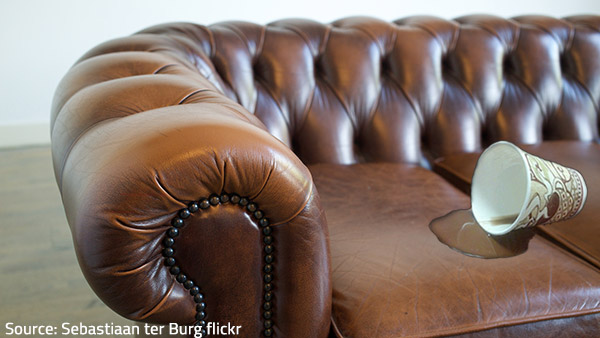
Stains can ruin all the beauty of leather furniture, so take care of them immediately.
Water Stains
If you manage to blot the water the moment it was spilled, no stain will remain. However, if the water has already dried and stained your leather, wipe gently with a soft damp cloth outwards towards the edges of the stain. This should result in a uniform effect for the entire treated area and make the stain invisible.
Fat-Based Stains
Don’t wet the leather at all! Just press down a soft dry cloth to blot up as much grease as possible and allow some time for the spot to dissipate. If you are still not satisfied, sprinkle talcum powder on the surface. After letting it rest for a couple of hours, vacuum the powder using the soft brush attachment of your cleaner. It should have absorbed the grease. Repeat, if necessary, but don’t rub or you will ruin the leather.
Ink Stains
Whether from newspapers or ball-point pens, ink stains definitely mar the look of your leather. Spray the spot lightly with aerosol hair spray and blot with a dry cloth. If the stain persists, rub gently over with a cotton swab dipped in rubbing alcohol and dry thoroughly. You can try the same approach for paint stains too but if the paint contained rich dyes, the stains may not come out at all. However, use alcohol only with great caution and keep in mind that it may damage the color of your leather, so if the stain is large and severe, have it professionally treated.
Dark Stains
Stains from coffee, juices, red wine, blood, tomato sauce etc. set in deeply and are extremely difficult to clean. Use a heavy duty cleaner but be extra careful because it will be slightly abrasive. You may apply some toothpaste or a paste made of one part cream of tartar and one part lemon juice. Leave the paste on the stain for 10-15 minutes and then clean with soapy water as described above. Remember to first test the cleaner (or the paste) on a small part of the leather that is hidden from view and never scrub vigorously to avoid further damage. Rinse well and dry thoroughly, then apply the leather conditioner and buff with a clean cloth.
Stains from Urine and Other Bodily Fluids
Absorb the liquid as well as possible, then moisten with clean water and blot by pressing a white towel on the spot. If you prefer to use an oxidizing stain remover or some other quality product designed for leather furniture care, mind the fact that discoloration may occur. You may have to apply a coat of matching colorant and then leather sealant to seal the color and prevent fading.
Mold Patches
If mold has developed on your leather furniture, spray the spot with a solution of water and white vinegar. Use as little liquid as possible and blot the spot dry immediately. Vinegar is a mild disinfectant and should effectively eliminate mold spores. You can use the same solution for other persistent stains as well, but be very careful and always test it first.
Bonus Leather Furniture Care and Cleaning Tips
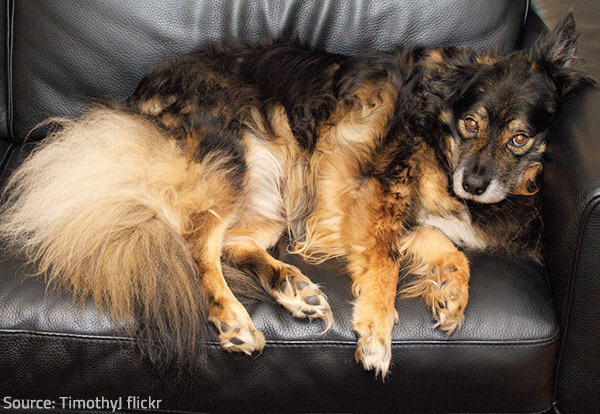
Not a real threat to your leather furniture but opt for a sofa with a protective finish, just in case.
- Never use cleaning solvents, oils, furniture polish or varnish, or any products containing silicone, petroleum or artificial waxes as they may render the leather incapable of breathing and feeling sticky;
- Never use alkaline cleaners (such as baby wipes) on your leather furniture because they may damage the finish or cause discoloration (the same applies to alcohol too);
- Avoid bleach and any other ammonia-based cleaners (as well as saddle soap, detergent and abrasive agents, as already discussed) because they are too harsh and can easily damage the delicate leather;
- You can gently buff slight scratches on the surface with a chamois and then apply leather balm. Gently moistening with distilled water may also help;
- Finishing with a leather conditioner will keep the surface supple and flexible and will prolong the life of your leather furniture.
- The experienced approach of professional leather specialists may save the day and your furniture, however severe the problem is!
If you have any doubts concerning the proper way to clean your leather furniture or find the task too intimidating, hire professional upholstery cleaners to ensure the best possible results and to avoid any potential damage to the leather. You will be able to enjoy your luxurious surroundings for many carefree years.












